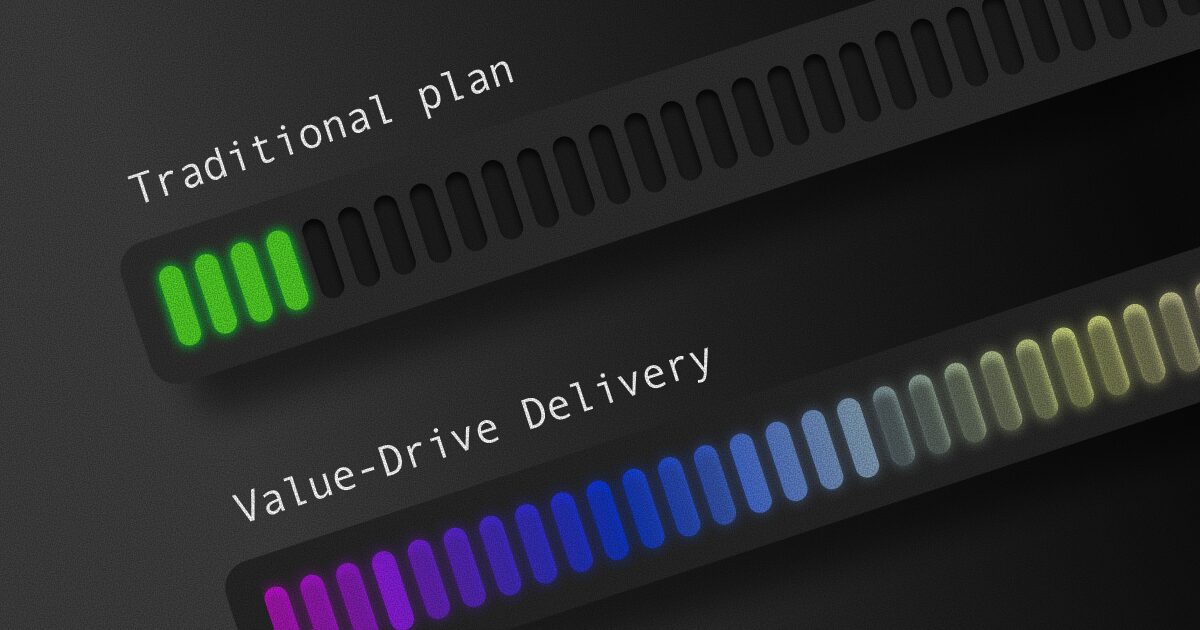March 25, 2025 - 6 min
Corporate App Development Explained: Types, Key Differences, and Development Steps

Corporate app development is a major driver within the area of software development in today’s world. It can provide your client with a software product, that is, an app that meets their customers’ specific needs. Corporate apps are usually divided into two types. These two are internal-facing and customer-facing applications. Of course, each of these two types has its own special purpose and caters to a different end customer.
In this article, we’ll show the difference between internal-facing and customer-facing apps; and as an example of an internal-facing app we’ll present the case study for Jenz, an employee engagement app developed and used by Q. Also, we’ll go through what to consider when developing a corporate app, and review the steps needed for its development.
Let’s get started.
1) Internal vs Customer-Facing Corporate App Development
As the name suggests, internal-facing apps are designed to be used within the organization itself, with the aim of increasing the level of communication and boosting the productivity of company employees.
Examples of internal-facing apps:
- HR management software solutions: HiBob, Workable
- Project management tools: Asana, Trello
- Internal communication apps: Jenz, Slack
One example of an internal communication tool is Jenz. An internal social network that we use on a day-to-day basis as our main communication tool for important official announcements. Employees themselves can also use Jenz to post their own posts, so it’s often called ‘Instagram for employees’.
The second type, customer-facing apps are developed for external customers — as the name itself suggests. They provide insight into the services and products that a particular business offers and aim to improve the overall customer experience.
Just a few examples of customer-facing apps (among many) are Revolut in the fintech industry, Booking.com in the travel industry, and Allianz in healthtech.
What sets internal- and customer-facing apps apart?
Target Audience. Internal-facing apps are primarily developed for use within organizations, while customer-facing apps are intended for a user demographic who has the specific need and benefits from using your app.
Main objective. With internal-facing apps, the most common main goal is to increase productivity and facilitate communication and workflows within the company. On the other hand, with customer-oriented apps, there’s a wide array of services that make the app interact directly with customers, facilitate the use of the app easier, and ultimately the business growth of the company who owns the app — based on the app’s success.
Security and Compliance. Both types of applications must strictly adhere to security and compliance measures, but with those oriented to internal use, it is important that the data of both users and companies are protected, meanwhile with customer-facing apps, it’s important that they adhere fully to the protection of their users’ data. Because just one data breach can mean huge financial losses and loss of consumer trust in your product.
2) What to Consider During Corporate App Development
Here are the main considerations to take into account when developing these types of apps.
What’s the App’s Goal?
First and foremost: define the basic purpose of the app and ask questions like What problem can my app solve? Who is my target audience? How can my app help them? These are the questions you should ask right away to set up proper goals from the very start.
Regular Maintenance
Nothing can live long without proper and regular maintenance, including [corporate] apps. From fixing bugs in the code, updating the entire software and ensuring that your app is compatible with new OS versions — all of this is necessary to make the user experience with your app as seamless as it gets.
Scalability Options
Most often, all apps start as simple software solutions that later need to be updated with new functionalities and features. Or to be ready for a larger number of users sometime in the future. The key is the ability to scale your app, which ensures that your product is ready and prepared for growth in all aspects.
Automation
Automation is indispensable nowadays because it speeds up various processes and makes it easier for us humans not to waste time on repetitive tasks. Instead, we can focus more on strategy, planning and organisation when developing this type of app. In short, automation equals higher efficiency. And that’s why when developing corporate apps, keep in mind how to automate, or in other words, optimise development processes as best as possible.
How to Measure Success?
The essence of every software product, including corporate apps, is to bring success — in terms of revenue, overall business growth, etc. For this, there are indicators of success, a.k.a. KPIs that help us to get insight into whether our product’s been successful. Here are some of the main KPIs to look out for:
- Engagement metrics
- Adoption rate
- Downtime occurrences
- Overall responsiveness rate
- Customer satisfaction rates/scores
- App retention rate
- Return on investment (ROI)
3) Steps in Corporate App Development
Every process, app development process included, requires well-structured steps. Here are the main steps put into the context of developing a corporate app.
Defining the Purpose. Have you aligned your app’s objectives with your business goals? This is your starting point.
Collecting Requirements. This step is where you need to involve all stakeholders so that everyone involved in the project knows what is expected of them.
Design Phase. Needless to say, the app design that meets the needs of any user is a must. Both user interface and user experience need to be top-notch if you want your app to become and remain successful.
Development Phase. This phase includes software engineers who will develop your application. From frontend to backend and all other roles related to the product’s development. The earlier steps are also crucial so that developers have fewer potential obstacles during the development process.
Testing. There are two main types of tests that are performed primarily by QA testers, though some may also be performed by developers. The main two types are manual and automated testing, and functional and non-functional testing. All of these tests are designed to check for potential errors and ensure a seamless user experience.
Deployment. Whether it’s an internal application or one intended for external users, in the deployment phase, it is released for use. Here, it’s important that all parameters are met so that the app can ultimately be available to the end user with the UX being seamless.
First Users’ Insights. Feedback from first users is more than helpful, always. The app can be made available to a test group who can provide feedback and identify specific issues that need to be fixed before releasing the app en masse. In other words, to the entire target audience.
4) Jenz — Case Study
Jenz is a mobile app developed originally here at Q, with its main purpose to serve as an internal social network, live newsletter, and intranet for companies. Nowadays, when many employees work remotely, with its features, Jenz helps encourage better communication and employee feedback.
Also, as an official company intranet and social media network, it helps strengthen the sense of community within the company. We use it at Q as well, but the list of clients using this app goes beyond borders, and even extends to as far as Australia.
Discovery. The discovery phase started with diving deep into the research oriented towards employees’ needs. And of course, the team made sure to take into account the best industry practices. Our discovery team came up with the features that proved to be of greatest benefit to employees — those that will boost productivity and increase engagement, and, consequently, employee satisfaction.
Design. The design of the Jenz app is sleek and visually appealing. It includes features like anonymous shouts to which the company management replies transparently, and frequent polls and surveys that also contribute to increasing transparency from higher management towards employees. Also, there’s a feature called ‘kudos’, an easy and effective employee recognition perk that lets your colleagues know you appreciate the work they’ve done.
Development. The team of developers used the Agile approach during the development phase. Regarding frontend, Flutter team stepped onto the stage, whereas on the backend side, PHP developers were in charge. The result? A prime example of a fully functional internal-facing corporate app development.

Results Achieved:
- Employee Satisfaction: +9/10
- Kudos Sent: +6.5k
- Anonymous Shouts Sent: +800
What do these results show? That this internal-facing app achieved its purpose. A higher level of employee engagement and their overall satisfaction are higher than before Jenz was introduced to the company.
Conclusion
Corporate app development involves setting clear goals and careful planning of the entire process. In the article, we mentioned that there are two types of corporate apps: internal-facing and customer-facing apps. With either type, the same principle applies. Their aim is primarily to increase efficiency (whether it’s the people within an organization or external customers), and create an above-average user experience in order to ensure the success of the product itself.
Structure in the development process is key, and we’ve shown this in the example of our app, Jenz, an example of an internal-facing app. The success of Jenz shows us that with a good strategy and well-crafted plan execution, this app can turn into an extremely successful product.
With both types of corporate apps, the most important thing is that it brings value to end users. We are here to provide value with our skilled and experienced professionals.
Feel free to contact us if you have an idea for the development of a corporate app.
 A big thank you to Vinka Durdevic for co-authoring this blog post. A Project Manager with 12 years of experience in IT, she transitioned from her role as a software developer more than five years ago. Vinka enjoys working on dynamic projects and loves collaborating with teams to get things done.
A big thank you to Vinka Durdevic for co-authoring this blog post. A Project Manager with 12 years of experience in IT, she transitioned from her role as a software developer more than five years ago. Vinka enjoys working on dynamic projects and loves collaborating with teams to get things done.
Give Kudos by sharing the post!






